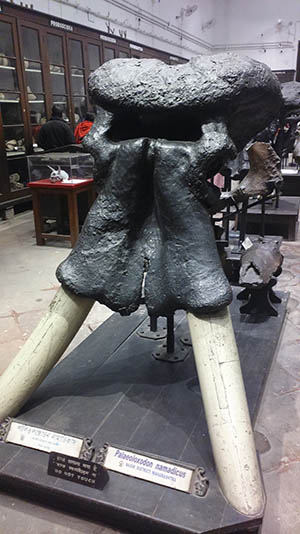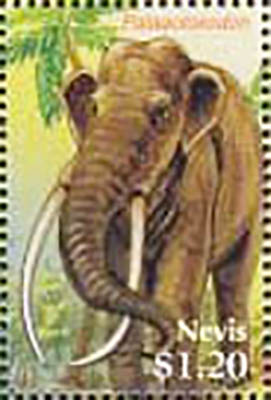Palaeoloxodon namadicus Falconer & Cautley,, 1846

(Da: it.wikipedia.org)
Phylum: Chordata Haeckel, 1874
Subphylum: Vertebrata Cuvier, 1812
Classe: Mammalia Linnaeus, 1758
Ordine: Proboscidea Illiger, 1810
Famiglia: Elephantidae Gray, 1821
Genere: Palaeoloxodon Matsumoto, 1924
Descrizione
Si tratta di un discendente del Palaeoloxodon antiquus, rispetto al quale la somiglianza (soprattutto nelle zanne) è così stretta che alcuni autori lo ritengono piuttosto una sottospecie. La struttura del teschio di questi animali è differente da quella di un elefante moderno. Diversi studi hanno cercato di stimare le dimensioni di questi elefanti, così come per altri proboscidati preistorici, tramite confronti fra le misure delle ossa e la conoscenza del tasso di crescita relativo, per poter sopperire all'incompletezza degli scheletri. Uno scheletro parziale rinvenuto in India nel 1905 aveva un femore la cui lunghezza una volta completo raggiungeva i 160 centimetri (5,2 ft) suggerendo un'altezza della spalla di 4.3 metri e un peso di 14 tonnellate per l'individuo. Due femori parziali rinvenuti nel XIX secolo sarebbero misurati 155 centimetri una volta completi. Un frammento dello stesso luogo era un quarto più grande. Le analisi volumetriche stimano un'altezza di 5 metri al garrese e un peso di 22 tonnellate. Ciò renderebbe P. namadicus il più grande mammifero terrestre di sempre, superando anche il più grande esemplare di Indricotherium e doppiando la stazza del dinosauro Diplodocus carnegii.
Diffusione
Specie di elefante peistorico vissuta durante il Pleistocene in Asia, dall'India (dove venne scoperto) al Giappone, dove veniva cacciato dalle culture del Neolitico.
Bibliografia
–Ferretti, M.P. (May 2008). "The dwarf elephant Palaeoloxodon mnaidriensis from Puntali Cave, Carini (Sicily; late Middle Pleistocene): Anatomy, systematics and phylogenetic relationships". Quaternary International. 182 (1): 90-108.
–Larramendi, Asier; Zhang, Hanwen; Palombo, Maria Rita; Ferretti, Marco P. (February 2020). "The evolution of Palaeoloxodon skull structure: Disentangling phylogenetic, sexually dimorphic, ontogenetic, and allometric morphological signals". Quaternary Science Reviews. 229: 106090.
–Jukar, Advait M.; Bhat, Ghulam; Parfitt, Simon; Ashton, Nick; Dickinson, Marc; Zhang, Hanwen; Dar, A. M.; Lone, M. S.; Thusu, Bindra; Craig, Jonathan (2024-10-11). "A remarkable Palaeoloxodon (Mammalia, Proboscidea) skull from the intermontane Kashmir Valley, India". Journal of Vertebrate Paleontology.
–Larramendi, Asier (2023-12-10). "Estimating tusk masses in proboscideans: a comprehensive analysis and predictive model". Historical Biology: 1-14.
–Larramendi, Asier (2015). "Proboscideans: Shoulder Height, Body Mass and Shape". Acta Palaeontologica Polonica.
–Paul, Gregory S.; Larramendi, Asier (June 9, 2023). "Body mass estimate of Bruhathkayosaurus and other fragmentary sauropod remains suggest the largest land animals were about as big as the greatest whales". Lethaia. 56 (2): 1-11.
–Romano, Marco; Bellucci, Luca; Antonelli, Matteo; Manucci, Fabio; Palombo, Maria Rita (2023-06-13). "Body mass estimate of Anancus arvernensis (Croizet and Jobert 1828): comparison of the regression and volumetric methods". Journal of Quaternary Science. 38 (8): 1357-1381.
–Biswas, Deep Shubhra; Chang, Chun-Hsiang; Tsai, Cheng-Hsiu (July 2024). "Land of the giants: Body mass estimates of Palaeoloxodon from the Pleistocene of Taiwan". Quaternary Science Reviews. 336: 108761.
–Ghosh, Rupa; Sehgal, R. K.; Srivastava, Pradeep; Shukla, U. K.; Nanda, A. C.; Singh, D. S. (November 2016). "Discovery of Elephas cf. namadicus from the late Pleistocene strata of Marginal Ganga Plain". Journal of the Geological Society of India. 88 (5): 559-568.
–Patnaik, Rajeev; Singh, Ningthoujam Premjit; Paul, Debajyoti; Sukumar, Raman (2019-11-15). "Dietary and habitat shifts in relation to climate of Neogene-Quaternary proboscideans and associated mammals of the Indian subcontinent". Quaternary Science Reviews. 224: 105968.
–Maurya, Sakshi; Ghosh, Rupa; Sehgal, Ramesh Kumar; Srivastava, Pradeep; Shukla, Uma Kant; Singh, Abhishek Pratap; Sarangi, Shushanta (September 2022). "Stable Isotopic studies of the herbivorous mammals from the Marginal Ganga Plain, India: implication for the palaeo-environmental reconstruction". Geological Journal. 57 (9): 3935-3948.
–Louys, Julien; Curnoe, Darren; Tong, Haowen (January 2007). "Characteristics of Pleistocene megafauna extinctions in Southeast Asia". Palaeogeography, Palaeoclimatology, Palaeoecology. 243 (1-2): 152-173.
–Geer, Alexandra A. E.; Bergh, Gerrit D.; Lyras, George A.; Prasetyo, Unggul W.; Due, Rokus Awe; Setiyabudi, Erick; Drinia, Hara (August 2016). "The effect of area and isolation on insular dwarf proboscideans". Journal of Biogeography. 43 (8): 1656-1666.
–Lister, Adrian M. (2004), "Ecological Interactions of Elephantids in Pleistocene Eurasia", Human Paleoecology in the Levantine Corridor, Oxbow Books, pp. 53-60.
–Jukar, A.M.; Lyons, S.K.; Wagner, P.J.; Uhen, M.D. (January 2021). "Late Quaternary extinctions in the Indian Subcontinent". Palaeogeography, Palaeoclimatology, Palaeoecology. 562: 110137.
–Turvey, Samuel T.; Sathe, Vijay; Crees, Jennifer J.; Jukar, Advait M.; Chakraborty, Prateek; Lister, Adrian M. (January 2021). "Late Quaternary megafaunal extinctions in India: How much do we know?". Quaternary Science Reviews. 252: 106740.

|
Data: 07/07/2015
Emissione: Elefanti preistorici del Nepal Stato: Nepal |
|---|

|
Data: 07/06/2005
Emissione: Animali preistorici Stato: Nevis |
|---|